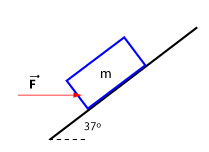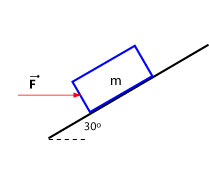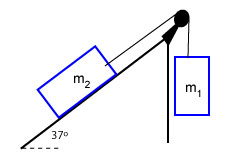Static and Dynamic Equilibrium
Helena Dedic
•Equilibrium: An object is said to be in equilibrium if and only if the sum of all forces exerted on this object is equal to zero.
•We call the sum of forces exerted on an object the net force and use the symbol .
•When the net force on an object is equal to zero then this object is either at rest (static equilibrium) or moving at constant velocity (dynamic equilibrium).
Beware: Many of the solutions to these exercises use !
Exercise 1
Two blocks with masses kg and hang under one another. The maximum allowable tension in the upper rope is N and the maximum allowable tension in the lower rope is N. Find the maximum mass and the tensions in the (massless) ropes when the two blocks are at rest.

Exercise 2
A 5 kg block on a 37° incline is acted on by a horizontal force of 40 N. It is moving up the incline at 6 m/s. What are the normal force and the force of friction acting on this block?

Exercise 3
An 8 kg block at rest on a 30° incline is acted on by a horizontal force of 30 N. What is the direction of the force? Determine the magnitude of the normal force and the force of friction acting on this block?

Exercise 4
Two blocks of equal masses kg are connected via a pulley. Find the force of friction given that is moving down at 5 m/s.

Exercise 5
A spring of spring constant N/m supports an 8 kg block. How much does the spring stretch when the spring moves up at constant velocity?
